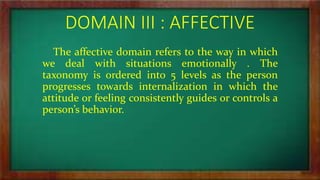Three Types of Learning: Affective Domain
•Download as PPTX, PDF•
3 likes•432 views
The document discusses the affective domain of learning, which refers to how people deal with situations emotionally. It organizes the affective domain into 4 categories from observing to adapting. The first category, observing, involves paying attention to physical activities or others. The second, imitating, is attempting to copy behaviors. The third, practicing, means repeatedly performing activities until they become automatic. The fourth category, adapting, is fine-tuning skills and adjusting performance in new situations. The document then lists learning outcomes for each category.
Report
Share
Report
Share

Recommended
Recommended
More Related Content
What's hot
What's hot (20)
Learning/Thinking Styles and Multiple Intelligences

Learning/Thinking Styles and Multiple Intelligences
Performance-Based Assessment (Assessment of Learning 2, Chapter 2))

Performance-Based Assessment (Assessment of Learning 2, Chapter 2))
Harlow’s taxonomy of objectives in the psychomotor domain

Harlow’s taxonomy of objectives in the psychomotor domain
Roles of Assessment in Making Classroom Instructional Decision

Roles of Assessment in Making Classroom Instructional Decision
Affective Domain in taxonomy of educational objectives

Affective Domain in taxonomy of educational objectives
Shift to educational focus from content to learning outcome

Shift to educational focus from content to learning outcome
Similar to Three Types of Learning: Affective Domain
Similar to Three Types of Learning: Affective Domain (20)
Naila Khalida Fitriani 4520210097 tugas interpersonal skill 3

Naila Khalida Fitriani 4520210097 tugas interpersonal skill 3
Tugas 3 interpersonal skill faeqal hafidh muhammad asfian

Tugas 3 interpersonal skill faeqal hafidh muhammad asfian
Chapter 6 Strategies and Methodologies in Health Teaching.pdf

Chapter 6 Strategies and Methodologies in Health Teaching.pdf
Recently uploaded
Recently uploaded (20)
Ecological Succession. ( ECOSYSTEM, B. Pharmacy, 1st Year, Sem-II, Environmen...

Ecological Succession. ( ECOSYSTEM, B. Pharmacy, 1st Year, Sem-II, Environmen...
Measures of Central Tendency: Mean, Median and Mode

Measures of Central Tendency: Mean, Median and Mode
Unit-IV; Professional Sales Representative (PSR).pptx

Unit-IV; Professional Sales Representative (PSR).pptx
Z Score,T Score, Percential Rank and Box Plot Graph

Z Score,T Score, Percential Rank and Box Plot Graph
This PowerPoint helps students to consider the concept of infinity.

This PowerPoint helps students to consider the concept of infinity.
Unit-V; Pricing (Pharma Marketing Management).pptx

Unit-V; Pricing (Pharma Marketing Management).pptx
Seal of Good Local Governance (SGLG) 2024Final.pptx

Seal of Good Local Governance (SGLG) 2024Final.pptx
ICT Role in 21st Century Education & its Challenges.pptx

ICT Role in 21st Century Education & its Challenges.pptx
Mixin Classes in Odoo 17 How to Extend Models Using Mixin Classes

Mixin Classes in Odoo 17 How to Extend Models Using Mixin Classes
Beyond the EU: DORA and NIS 2 Directive's Global Impact

Beyond the EU: DORA and NIS 2 Directive's Global Impact
Three Types of Learning: Affective Domain
- 1. DOMAIN III : AFFECTIVE The affective domain refers to the way in which we deal with situations emotionally . The taxonomy is ordered into 5 levels as the person progresses towards internalization in which the attitude or feeling consistently guides or controls a person’s behavior.
- 3. Re-organized and simplified into 4 categories or levels Categories/Level Learning Outcomes Statements 2.1 Observing : active mental attention to a physical activity Detect non-verbal communication cues; watch a more experienced person ; observe and read directions 2.2 Imitating : attempt to copy a physical behavior Show understanding and do sequence of steps with assistance ; recognize ones limitations 2.3 Practicing: performing a specific activity repeatedly Operate quickly and accurately ; display competence while performance is moving towards becoming automatic and smooth. 2.4 Adapting : fine tuning the skill and making minor adjustments to attain perfection Perform automatically ; construct a new scheme/ sequence ; apply skill in new situation ; create a new routine , develop a new program
- 4. Categories and levels Learning outcomes statement 3.1 Receiving : being aware or sensitive to something and being willing to listen or pay attention Listen to others with respect , try to remember profile and facts 3.2 Responding : showing commitment to respond in some measure to the idea or phenomenon Participate in discussions ,gives expectation ; know the rules and practice them ; question concepts in order to understand them well 3.3 Valuing : showing willingness to be perceived as valuing or favoring certain ideas Demonstrate belief in the concept or process ; show ability to resolve .Ranges from acceptance to commitment. 3.4 Organizing : arranging values into priorities , creating a unique value system by comparing and relating Accept responsibility ,recognize the need for balance between freedom and responsible behavior . 3.5 Internalizing : practicing value that controls ones behavior ; exhibiting behavior that is predictable and characteristic of the person Cooperate in group activities .
